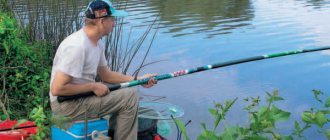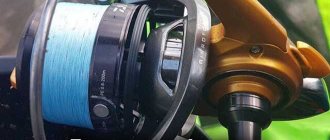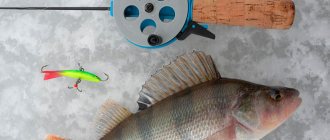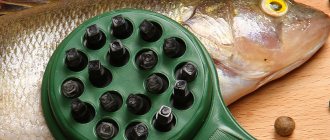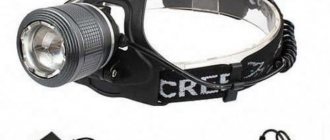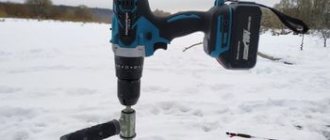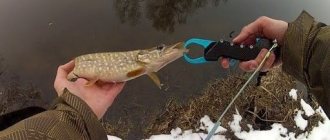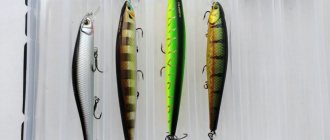This predator is voracious throughout the open water season and seems to be constantly moving in search of new prey. In winter, after the reservoirs are covered with ice, the pike does not hibernate like other aquatic inhabitants, and fans of ice fishing enjoy hunting the silvery beauty.
Only fishing for girders competes with it, but in a stubborn struggle it still loses. In addition, fishing with girders is inactive and after installing baits, the angler has to patiently wait for a bite, wrapping himself in warm clothes.
Fishing with balance beams is active and you won’t be able to freeze. In addition, by using standard fishing rods, as well as inventing new ones, the fisherman improves and develops, increasing his performance. From the point of view of culinary value, winter pike is preferable to summer pike and its excellent taste is noted by all fans of fish dishes.
But we are talking about fishing with balance beams, and when fishing from ice, an angler not only needs to be able to choose a catchy bait, but also know how to use it correctly. The technique of wiring with balancers leaves a lot of room for creativity, although standard methods of playing with a balancer are not at all difficult to learn, and this gives you a chance to catch trophy fish.
Why should you catch pike with balance beams in winter?
In conditions of low air and water temperatures associated with ice fishing, the angler’s options for choosing gear are limited, as are the sectors in which fishing is carried out. This summer, in clear water, they move by boat throughout the entire water area and catch pike using spinning tackle with baits like:
- spinners;
- silicone;
- wobblers;
- live bait;
- poppers;
- balancers
Some anglers and balancers call them horizontal spoons, although this is not entirely true. Indeed, an artificial fish - a balancer - is located horizontally in the water and, thanks to the nodding movements of the fishing rod, imitates the behavior of live bait.
But unlike a standard spinner, this bait is equipped with two hooks (in the front and back), as well as a tee located under the belly. That is, in any direction of attack of a predator, a steel sting of a hook or hooks awaits it. This fact alone increases the effectiveness of fishing with balance beams.
In addition, balance spinners fish the entire coastline, and in search of promising places, they travel thousands of meters during daylight hours. In this case, you have to regularly drill holes and spend energy on it, but when you bite a trophy, both inconvenience and fatigue are forgotten.
When fishing with girders, after installing the traps, the angler cannot in any way influence the behavior of the pike standing in the fishing sector. If she becomes interested in live bait, a bite will follow, but this does not always happen.
Like other predators, pike is curious and is able to detect prey not only visually, but also by sound waves and water vibrations. Even if the bait is fresh, this does not mean that it is actively moving in the water column and thus attracting predators.
Catching pike with a balance beam is more effective, since the angler uses various fishing techniques, and the bait in the form of an artificial fish is constantly in motion, imitating the active behavior of real underwater inhabitants.
Balancers for pike differ in design and color, but successfully cope with the task of attracting and catching fish.
Advantages of catching pike with balance beams:
- the bait is similar to live fish, but unlike live bait, it is used repeatedly;
- fishing a wide area under the hole with a balancer;
- numerous wiring techniques that increase performance;
- reliable hooking of the trophy and comfortable fishing;
- The bait catches both small pike and large trophies.
Despite the fact that live bait was considered the best bait for pike, balancers proved their “professional suitability”, and the ease of their use was beyond doubt. When going to a winter pond, fishermen take with them a set of balance beams of different shapes, weights and colors and reasonably expect to catch a silver predator.
Advantages of fishing with a balance beam
Winter fishing for pike differs from summer fishing in that it is more mobile and this means that you are doomed to a predator, and the predator is doomed to a balance beam. This bait realistically and accurately imitates a small fish, unlike a vertical spoon. It allows you to cover a larger area.
He has a very sharp and smooth game. The balancer is equipped with a tee under the belly, as well as single hooks in the tail and bow. Such variety and specific arrangement of hooks significantly increase your chances of a reliable hook in the jaw of a predator. For regular vertical spinners.
The advantage of these baits over other baits are the following factors:
- wide variety of colors,
- affordable price for all fishing lovers,
- beautiful and realistic game in depth.
The most popular time of year for fishing with a balance beam is winter. At this time of year, you can freely walk on the ice, drill a large number of holes and look for pike. There are many features in winter fishing with a balance beam. For example, subtleties in playing with bait, which has several periods. Each pause lasts from 2 to 6 seconds. Fish can take bait both on the bottom and on top. Don't forget to experiment.
The balancer is not always popular in winter. In summer it can also give good results. The summer one also has quite a few subtleties. In summer, you need to pay special attention to coloring. You should have at least 5 gear in your arsenal. Fishing techniques should be varied.
It’s not enough to just play with the bait, you need to make pauses of different times, fast and slow swings. If you are targeting a pike, then the technique of sharp strokes, oscillating in different directions, is more suitable for you. This technique teases and the predator simply has to respond to these provocations.
Where and when is it better to catch pike with balance beams?
Choosing the right place to catch winter pike is the key to successful fishing and it is not surprising that experienced anglers take this procedure seriously. When constantly fishing in the same body of water, everything is much simpler, because it has been explored far and wide and fish sites are found in advance.
If the reservoir is new and unfamiliar, you will have to work hard to find the pike and provoke it to bite, and this applies not only to the place, but also to the horizon of the predator’s parking area.
It has been noticed that after the autumn active hunting season, the pike that has eaten its belly prefers to settle down in the upper layers of the water, showing no desire to hunt. But after adapting to new climatic conditions and the beginning of the hungry season, the pike is forced to look for prey in all directions, which complicates the fisherman’s task.
Drilling holes in the cold is not an easy task, but the variability, and therefore the effectiveness of the session, depends on its solution. The more holes, the greater the likelihood of finding pike sites, although there is no direct relationship and you shouldn’t count on it.
On the first and last ice, the pike bite becomes more active, although in the dead of winter, when there are practically no other trophies, the pike helps out with its bites and pleases with trophy specimens. Another thing is that in the middle of winter they look for pike in pits, where it waits out difficult, hungry times.
But even in this case, the skill of the fisherman and the ability to make attractive fishing helps out, so you shouldn’t sit at home even in severe frost, although drilling through thick ice will not be easy.
The most intense pike bite is observed at the end of winter, when the ice melts, the timid spring sun shines and hunger becomes especially acute. The instinct of a predator tells you that it’s time to go hunting, and potential victims are waking up from hibernation.
If fishing is carried out on the river, promising places are in the areas of channel edges, at turns, where there are necessarily holes and undercuts. These are the favorite stopping places for small fish hiding from enemies, and, naturally, there is also a predator nearby, choosing a prey for hunting.
Winter moorings for pike are in the same places as summer ones and they are easier to find in a well-studied reservoir. In unfamiliar places, areas with underwater vegetation are fished, next to reed thickets where trophy specimens stand.
Particularly interesting are places where there are flooded trees or snags, because this is protection for the fry, which the silver predator loves so much.
Pike is not a schooling fish and prefers to hunt alone, but in places where bream or roach gather, several pikes gather, knowing that there is enough food for everyone. In the middle of winter, trophy pike stay closer to the bottom, moving closer to the surface as the temperature warms and pressure increases. Like any other fish, this predator is sensitive to oxygenated water and is not afraid to approach the hole if the angler is quiet.
It cannot be said that during the day at some moments the pike bites better; a good bite happens in the morning, during the day and even at night, it all depends on its “mood” and physical condition.
How to choose a balancer for pike
A balancer is a bait for fishing with spinning rods and winter fishing rods that looks like a white fish fry. The peculiarity of this bait is that it balances when retrieved vertically and, thanks to this, attracts the attention of predatory fish.
When you swing the fishing rod, the balancer “scours” in the water, and during a pause it returns to its original position. The small size of the balancers and sharp hooks in the head and tail, as well as a tee in the abdominal part, ensure reliable hooking of pike or pike-perch with perch.
The tail of the bait is made of plastic or wool. The body is narrow or wide, as if flattened. Narrow balancers fish small areas when moving, but flattened ones “walk” widely in the water column, drawing circles and figure eights, attractive to a predator going hunting.
Most often, the pike attacks the balancer from the tail part and is caught with the rear hook and tee. Replacing plastic plumage with fur increases the attractiveness and therefore the catchability of the bait, but the sharp teeth of the pike quickly tear it off.
When fishing for perch or pike perch, the color of the balancer does not play a decisive role; these predators react more to the animation of the bait. But in pike fishing, color is much more important and bright artificial fish show the best results . This must be taken into account when reducing the intensity of the bite and “play” with the colors of the balancers used.
Choosing a catchable bait is one of the main conditions for successful fishing for a predator, and this applies not only to pike fishing. When using balancers, the process is simplified, especially since the design of the gear allows you to quickly change baits in the absence of a bite. For perch, small balancers are chosen, but for pike perch fishing, models of medium size and weight are preferable.
Pike balancers are the largest in size, regardless of what size fish you intend to catch. Even small pike greedily take a large bait, swallowing it almost completely, often across. Thanks to this style of biting, the predator is reliably caught with hooks, but more often with a tee. Experienced fishermen replace standard tees on balancers with larger ones so that the fish are guaranteed to be caught after a bite.
Tees are additionally decorated with beads or shiny lurex thread to increase their attractiveness.
Unlike zander or perch, pike balancers are brightly colored, because the visual appeal of the bait plays a big role. Pike sees perfectly even from a long distance and willingly “goes” to bright artificial fish.
In muddy water, yellow or white balancers are visible better, and it is good if the color contains a red color, reminiscent of a wound.
The same applies to the size of the bait; for pike, balancers with a length of 7 centimeters are used. This does not mean that a predator will not bite or will not be detected on a bait 3-4 centimeters long, it’s just that a large bait will cut off small perch , of which there are much more in the reservoir. A small predator is quicker and more reckless, so without hesitation it attacks a bait that is too tough for it, but will not be tempted by a large balancer.
Fishermen reduce the size of pike balancers only in the absence or decrease in the bite rate, but even in this case they try not to use baits smaller than 5 cm, cutting off the small things.
Targeted fishing for winter pike is rarely complete without perch or pike perch as bycatch, but large baits also increase the size of the catch.
Large balancers are also good because they weigh more, which means they sink faster to greater depths, to the holes next to which are the fish’s favorite spots.
Important! For lazy and inactive pike, lures with a fur tail work better.
The best balancers for pike in winter and catching pike with a balancer
Today we’ll talk about catching pike with a balancer and what kind of balancer for pike should be, we will publish a fresh rating of the best catchable balancers for pike fishing.
Let's start with material for novice anglers in which we will touch on such issues as determining the place to catch pike, tactics and techniques for catching pike with a balance beam, choosing a catchable balance beam and others.
The best pike balancers
The variety of artificial fish sometimes confuses novice fishermen, especially since some of them cost a lot and you don’t want to make the mistake of purchasing an expensive but of little use bait. Therefore, a very common question is related to the most catchy baits.
The conditional rating of the best pike balancers is based on reviews from existing fishermen, as well as sales indicators from retail chains. Naturally, the rating is conditional, but it helps to understand and make a profitable purchase.
Nils Master Nisa 50
The manufacturer of the Nils Master Nisa balancer positions it as a bait designed for catching pike in shallow waters or in deep-sea reservoirs at a depth of up to 3 meters.
The weight of the bait is 12 grams, length is 5 centimeters. To hold the Nils Master Nisa in a horizontal position when guiding, it is equipped with side stabilizer fins. Thanks to stabilizers, the attractiveness of the “game” of the balancer also increases, which is important when catching predatory fish.
A wide range of colors increases the attractiveness of the lures in this series, and the angler varies them depending on external conditions and the intensity of the bite. There are even luminous Nils Master Nisa, used when fishing in muddy water.
Advantages of a balancer:
- attractive and stable “game”;
- high quality workmanship;
- sharp and durable hooks that reliably catch trophies;
- durability.
Nils Master Nisa is a bait with which the angler feels confident on any type of reservoir, both with current and still water.
Kuusamo Tasapaino 50
Winter balancer for catching pike at a depth of up to 5 meters.
Weight – 7 grams, length 5 centimeters. The tail fin is made of plastic and painted red, attractive to pike that actively hunt in the upper layers of water. With the help of Kuusamo Tasapaino 50 they fish difficult, hard-to-reach areas where other baits do not show results. The narrow body helps to avoid snags, and the realistic coloring does not alarm the predator, but forces it to attack the artificial fish.
Advantages of the Kuusamo Tasapaino 50 balancer:
- streamlined body that helps with complex wiring;
- color resembling a real fish with a silver back and dark belly;
- durable hooks that can be easily pulled out of grass and even the trunks of flooded trees;
- red plastic fin that attracts fish and provides an attractive "game"
Kuusamo Tasapaino 50 is sure to be found in the top of the best lures for pike, and its catchability against this predator is beyond doubt.
Rapala Jigging Rap – w07
The lure Rapala Jigging Rap - w07 is also in the leading position in many ratings and is designed for catching trophy pike.
This is evidenced not only by statements from the manufacturer, but also by the size of the bait, the length of which is 7 centimeters. A weight of 18 grams is enough to quickly deliver the balancer to depth, and it is used to fish the bottom areas of rivers and lakes. When fishing near a hole or undercut, Rapala Jigging Rap - w07 is indispensable, as well as in the middle layers of water, especially during thaw periods.
Some anglers feel that the tail fin is not large enough to make a wide retrieve. But this is rather an advantage, because the sweeping “game” of the bait will not always interest the fish standing nearby. In the bottom layer there is often dense vegetation, and hooks with this balancer are rare, and strong hooks help save the bait by pulling it out of the grass.
Advantages of Rapala Jigging Rap – w07:
- high quality coating, ensuring the durability and attractiveness of the bait;
- original "game";
- wide choice of colors;
- durable, streamlined body that provides a natural “game” reminiscent of
- movements of the injured fry;
- Possibility of use both in the middle layers of water and near the bottom.
The Rapala company is famous for its products, in particular, lures for catching predators, and among the Rapala balancers for pike, the Jigging Rap - w07 is considered one of the best models.
Lucky John Pro Series Merabu 67
There is hardly a rating of predator baits that does not include models from Lucky John and Merabu, the 67th bright representative of the brand.
The balancer is designed for catching trophy pike at depth and in difficult conditions. Even a very strong toothed predator will not bite the bait, the body of which is made of a lead alloy, and the tail is made of impact-resistant plastic, resistant to low temperatures.
It is thanks to the long tail that when reeling, the bait quickly turns around and takes a stable position in the water.
The originality of the design of the balancer is the presence of three holes in the upper part, to which the leash is attached. This allows you to change the position of the bait in the water and diversify its animation.
Advantages of Lucky John Pro Series Merabu 67:
- attractive appearance;
- Durable materials are used in manufacturing;
- movable tees on the belly and tail;
- three holes for attaching a leash, helping to diversify the game of the bait;
- more colors for different weather and time of day.
Thanks to the beveled nose, the balancer “dives” in the water when moving, imitating the behavior of a live fish. Lucky John Pro Series Merabu 67 weighs 18 grams, length 67 mm.
Scorana ICE Fox 55
The bait is offered for catching pike and other trophy predators during periods of weak bite in the middle of winter at low temperatures.
At such times, the pike goes deeper and hunts near holes and cuts, without showing much activity. The Scorana ICE Fox 55 balancer works well both in the current and in the riser, luring fish with its bright colors and interesting “game”. The coating of the bait is an exact imitation of silver fish scales, hooks in the tail and head of an artificial fish, and a tee on the belly.
The weight of the balancer is 10 grams, length is 55 millimeters. Such characteristics make it possible to use the bait when fishing in shallow waters during thaw periods, when the fish rises to the surface, to a source of oxygen. The plastic tail ensures a stable position, and its bright color is attractive to predators.
Advantages of Scorana ICE Fox 55:
- versatility (works both on current and on riser);
- high-quality manufacturing of the case;
- reliable hooks and tee;
- color resembling a living fish.
The versatility and appeal of the Scorana ICE Fox 55 is the reason why every ice fisherman needs one.
The best balancer for passive pike
Scorana ICE FOX 55mm balance beams have proven themselves to be excellent when catching predators during the dead of winter. A characteristic feature of the bait is its stable play in shallows and depths, in still water and in small currents. The bait has a provocative appearance; pike and perch, even in a passive state, attack prey swimming nearby. With a balancer length of 55 mm, it weighs 10 g. If it is better to fish in shallow water areas on the first and last ice, then in the middle of winter it is preferable to fish deep-water points. Single hooks and a plastic tail are securely attached to the body of the bait. The body has a relief imitation of scales, which makes the balancer look realistic.
- challenging game;
- durable protective coating;
- high-quality assembly.
- tendency to twist the line.
Refinement of the balancer
The best balancers bought in a store still do not last forever, and to extend their service life, fishermen modify their design. First of all, this concerns the tail part, because the sharp teeth of the pike break the plastic plumage and tear out the fur “tassels”.
Before buying a bait, make sure that its tail is attached securely, and if necessary, it is additionally glued with quick-drying glue without an unpleasant odor.
On budget baits, hooks and tees are replaced with larger ones to increase the reliability of the hook. Once caught on a large and sharp tee or hook, the pike will not be able to spit out the bait and fishing it out will not be difficult.
The additional weight of the pike balancer also increases its catchability, and this is especially true for inexpensive models. This is done carefully, gradually increasing the weight of the bait, and at the same time checking how its “game” changes in a container of water or a bath.
The metal “tails” of artificial fish are unbent with pliers, and the bait glides better in the water during a pause. Plastic tails cannot be straightened by hand or using a special tool; to do this, they are heated over steam and the problem is solved.
To improve the planning of the bait in the water, it is equipped with plastic wings in the front part. If the belly of the balancer is flat, glue a piece of plastic to it, preferably transparent, so that the color does not change.
Plastic packaging for children's toys or boxes from balance beams are perfect for these purposes. In addition, such plastic is easier to work with, it is easy to cut with scissors, and does an excellent job when wiring.
Plastic wings are cut out in the same shape as the abdomen, only 2–4 mm wider. Before gluing with sandpaper, the surface of the plastic is roughened so that the connection is reliable. Additional wings increase the amplitude of the bait’s displacement when rising and pausing in the “game.”
The transparent tails of purchased balancers are painted with varnish in bright shades. This increases the attractiveness of the bait and visually increases its size.
Branded baits do not need to be loaded or changed hooks with tees and, despite the fact that they are more expensive, the difference in cost is more than compensated by the caught trophy predator.
Lures that have low hydrodynamic characteristics are usually subject to modification, but the catchability of the balancers depends on the fisherman’s ability to make the correct retrieves and on the gear that is used.
Tackle for pike fishing with balancers
When catching a predator with balance beams, the requirements for gear are generally similar, but still there are special requirements for pike gear.
The pike is not a perch, timidly fiddling with the bait and only occasionally “grabbing” it, so no hooking is needed. The silvery predator has practically no worthy rivals in reservoirs and pecks at an imitation live fish without hesitation, grabbing it with its sharp teeth. This can be not only a small tentacle, but also a real trophy, the dream of every angler. And the gear used for fishing on balance beams must correspond to the tasks being solved.
Gawky fishermen have more than once encountered the fact that after biting a trophy pike, the line broke, bitten by the sharp teeth of the predator. And in addition to the loss of fish, this is fraught with the loss of expensive bait, which will be useful on other fishing trips.
Therefore, pike balancers (unlike perch and zander) are tied not to a base, but to a leash that can withstand the teeth of a trophy pike.
The metal leash is a classic of the genre, and when fishing in warm water it does not confuse or alarm the pike. But in winter, in cold and clear water, the predator is more careful and a metal leash can scare it away.
A way out of the situation was found after the advent of fluorocarbon - an abrasion-resistant material, and also transparent. A fluorocarbon leash is somewhat inferior in strength to a metal leash, but this margin is enough to withstand pike teeth.
Another serious drawback of a metal leash is that its rigidity affects the control of the bait, and therefore its “game.” If an artificial fish looks unnatural and behaves unnaturally in the water, this will alert the predator and it will refuse to bite.
Expert opinion
Alexander Popov
Expert fisherman
To ensure a natural “game,” there must be clear contact between the tackle and the bait, and this cannot be achieved with a metal leash. Distorted play of the balancer due to the fault of the leash leads to disastrous fishing results, so when fishing for pike in winter, use fluorocarbon leashes and the performance increases.
The difference between pike winter gear is that when biting, the angler must make an accentuated hook in order to pierce the hard lip of the fish with the hook. It is impossible to make such a hook with a soft nod.
On the other hand, the whip also participates in catching a predator hooked and absorbs its jerks. A fiberglass nod up to half a meter long is the best option for catching winter pike. A hard nod will not allow you to see the delicate bites of the fish, but most often the pike suddenly grabs the bait and its bite is difficult not to notice even with a hard tip of the fishing rod.
The length of the fishing rod depends on the anthropometric data of the fisherman, because it should be convenient for him to make retrieves and quickly hook the fish. There are no restrictions or strict recommendations on the length of the fishing rod, the main thing is that it can withstand a trophy pike, and it is convenient to control the bait and make catchy retrieves.
An open-type reel will allow you to quickly lower the balancer to a given depth, and the brake will help you smoothly stop the line when fishing for a trophy predator.
Pike is not a perch or a pike perch, for catching which it is enough to have a supply of fishing line of 5–10 meters. A trophy specimen weighing 4–5 kg or more stubbornly resists, and in order not to break the base, you have to pull out the fishing line, tiring the fish.
Each angler decides for himself what to choose as the main fishing line. If you can put an expensive fluorocarbon fishing line on the base, then all problems are solved. Otherwise, the choice is between braid and monofilament, and the latter option is still preferable.
The braid is stronger and you can take a thinner base of 0.1 mm in diameter. The low stretch of braided fishing line helps when performing sharp strikes with high amplitude, guaranteeing the hooking of a predator with hooks or a tee.
But the disadvantages of braided line offset its advantages and it is not suitable for winter fishing. Braid cannot be called transparent or inconspicuous, and when it gets wet in cold water, it loses its best properties. Even a frost of 8–10º is enough to freeze the braid, and at the same time it loses its strength.
Therefore, anglers choose monofilament fishing lines for the base , and their stretchability (which is considered a disadvantage when hooking) turns out to be an advantage when fishing for trophy pike.
The diameter of the monofilament line for the base is 0.25-0.28 mm, although there are anglers who prefer to play it safe, they take monofilament with a diameter of 0.35 and even 0.4 mm. When fishing with a fluorocarbon leader, the camouflage of the base fades into the background, and when fishing with a thick line, the angler feels more confident and is not afraid of losing the trophy.
Using a thick fishing line has another advantage - it slows down the “game” of the balancer, and with a weak bite this gives an advantage. Like pike perch, pike more often take the bait during a pause in the “game” and with a thick fishing line it is easier to make such pauses.
But a thick base also has disadvantages:
- it sails more strongly when diving;
- the balancer moves more to the side when fishing;
- hooking worsens.
These shortcomings are not so critical as to cause the refusal of monofilament fishing line, therefore, when tying equipment for pike, experienced fishermen choose monofilament as the basis.
When assembling tackle for catching pike on a balance beam, you need to remember that it should be:
- reliable;
- universal;
- compact;
- functional.
Thanks to the use of a leash with a clasp, the process of changing the balancer is simplified, which is very important for the angler in cold weather. But it happens that due to lack of bite, you have to change the balancers in order to stir up the fish and still provoke it to bite.
But even the most correctly assembled tackle for fishing with balance beams does not guarantee an active pike bite and a good catch, because everyone recognizes that in the first place is the angler’s ability to “play” the bait in such a way as to lure the predator.
Tackle
the spinning rod itself
The tackle for catching pike on a balance beam is a winter spinning rod, always equipped with a reel. The length of the rod whip is from 30 centimeters to 1.5 meters. A smaller size may not allow you to play the balance beam correctly, while a larger size will create unnecessary problems during transportation.
It is in your best interests to ensure that the rod handle is covered with insulating material. Neoprene or cork will do.
Most fishermen use an ordinary inertial reel with a stopper. It is inexpensive and allows you to reel in and unwind the tackle relatively easily and quickly. However, a reel with a multiplier gives the best results. It allows you to adjust the brake force, which is useful when fishing for large fish.
It is recommended to use fluorocarbon as fishing line. The absence of memory effect and tendency to freeze, resistance to strong jerks and less visibility in the water in the eyes of the buyer are negated by only one drawback - high cost.
Ordinary nylon fishing line with a thickness of 2 to 3 tenths of a centimeter is widely used. Sometimes a braided cord is used. In the case of the latter, be extremely careful: if you take out your prey without gloves, you risk causing yourself serious damage with the cord.
A balance beam invariably remains a mandatory part of the equipment when fishing for pike . Without its use, there is a high risk of not only missing out on everything that was provoked to bite, but also losing catchy baits.
Techniques and tactics for catching pike with balance beams
Having arrived at the reservoir, the fisherman selects promising places and decides on fishing tactics. The presence of an echo sounder greatly simplifies the search for edges or undercuts, but even if there is no electronic equipment, this is done quite simply.
Starting to drill holes from depth, perpendicular to the coastline, measure the depth at each point and determine the bottom topography. Here you will have to work a little, but a sharp drill will solve all the problems.
Having drilled holes and determined the places where the pike stands, they begin fishing with the smallest balance beams. If there are bites in the hole, the balancers are enlarged to attract trophy fish, and a gel-like attractant is used to increase their attractiveness.
Sprays in such cases are ineffective, because the liquid is quickly washed off with water from the surface of the bait. The gel-like substance adheres better to the surface of the balancer, and its attractiveness increases and lasts longer.
Trophy pike rarely travel in schools, but small pike often gather next to it, hoping to feast next to their older comrade on scraps from his table. Therefore, when catching a pike, you need to enlarge the bait, choosing the appropriate size for the sharp teeth of the trophy pike.
Trophy pike are not that uncommon in winter fishing, because in the absence of a food supply, the predator reacts to artificial fish, mistaking them for a living fry. If after 4-5 series of fishing there are no bites in the hole, move on to the next one until they “feel” the fish. Experts recommend drilling holes in a checkerboard pattern in order to fish a wider area of the reservoir.
Where is the best place to catch pike with a balance beam?
The best options would be rivers, lakes and reservoirs. If you are going to fish on the river, then choose not wide ones, with a rich oxygen supply. Having entered the ice, move 10-12 meters away from the shore and start drilling holes parallel to the coastline.
Drill at least 8-10 holes to fish the place as best as possible. Beware of the reeds of underwater snags, but if you are a risk-taker, your risk can pay off with perch or pike perch, because they are frequent visitors to such places.
Catching wires
Wiring techniques when fishing for perch and pike at a depth of 5 meters or more are fundamentally different. If perch fishing with bait begins after the balancer hits the bottom and gradually raises it up, then fishing for pike begins at half-water, or even closer to the surface.
After a short swing of the rod, a pause of 5–10 seconds follows, and the balancer drops 30–40 cm from its original position. In this style, the bait is animated to the bottom, followed by a rise and the next pause-descent cycle.
In 8 cases out of 10, the pike bite occurs just at the moment of pause , when the bait is at rest or is gradually lowering. There are often cases when a predator closely monitors the bait and attacks, making sure of its attractiveness and safety.
You don’t need to think that the predator’s intelligence is not enough to understand if there is a catch. Therefore, the angler’s actions must be measured and precise in order to deceive and catch a pike.
Important! When fishing for pike, a timely pause is more important than the amplitude or speed of the retrieve.
If you have to fish on a sunny day, after drilling the hole, it is not completely cleared of slush so that the bright light does not scare away the predator.
When fishing in shallow water, retrieving begins in the lower layers of the water, raising the bait by 30–40 centimeters before a pause. A bite when the bait falls will require a sharp hook so that the hooks pierce the thick skin of the slave.
After hooking a trophy pike, you need to use the drag or ratchet of the reel, letting and reeling the line to the hole. It is wrong to fish out the fish sharply, pulling it to the hole “unforcedly”, the predator will simply break the fishing line, or the balancer will jump out of its jaws.
Absorbing the jerks of a predator with a rod and reel is an important part of fishing, especially if there is a heavy trophy on the hook.
In the absence or weak bite, fish the hole with 5-10 retrieves and move on to the next one to maintain the fishing pace. The duration of the pause should be commensurate with the amplitude of movement of the balancer in the water.
Important! Don’t forget that while drilling a hole, the pike standing nearby gets scared by the noise and moves away, so it’s important to remain quiet. We start fishing from the hole that was drilled first.
Fishing technique
The tactics do not differ significantly from those used when fishing with a spoon. In the selected area, up to a dozen holes are drilled at a distance of 10-15 meters from each other, usually in the so-called checkerboard pattern.
The hole that was drilled at the very beginning begins to be fished first. This is explained quite simply: the sound made when the ice drill rubs against the ice alerts underwater inhabitants and forces them to leave their camps for a while.
Therefore, fishing in the freshest hole is obviously a losing option. Usually they start baiting at mid-water, and if this does not bring success, they change the horizon. In one hole, a dozen to one and a half transactions of the balancer are made and, if there is no reaction from the predator, they move on to the next one.
If fishing all the holes does not produce results, it is repeated, after first changing the bait. As a last resort, it is possible to change the area and repeat the procedure.
The fishing technique is extremely simple. The bait is lowered to the fishing horizon and thrown with a sharp movement of the rod with an amplitude of 20-30 centimeters. After it reaches the bottom point of the trajectory (this will be noticeable by a characteristic weak blow), take a short pause and repeat everything again.
Most of the predator's attacks occur during this pause, and its absence in the balancer wiring has a detrimental effect on the number of bites. When fishing in the bottom layers, it is useful to complement the action of the bait with a couple of taps on the bottom. In this case, the hooks will touch the silt or sand and raise a cloud of turbidity, simulating the fuss of a small fish in search of food.
The bite occurs sharply and is usually perceived as a hook or blow. The hook should be struck immediately, with a short, sharp movement. After hooking, they drop a few meters of line and move on to fishing with constant reeling of the line. The most difficult task is to get the caught pike into the hole. A small hook can partially help solve this. After the pike is removed from the hole, it is useful to drop it on its side to prevent it from returning back.
